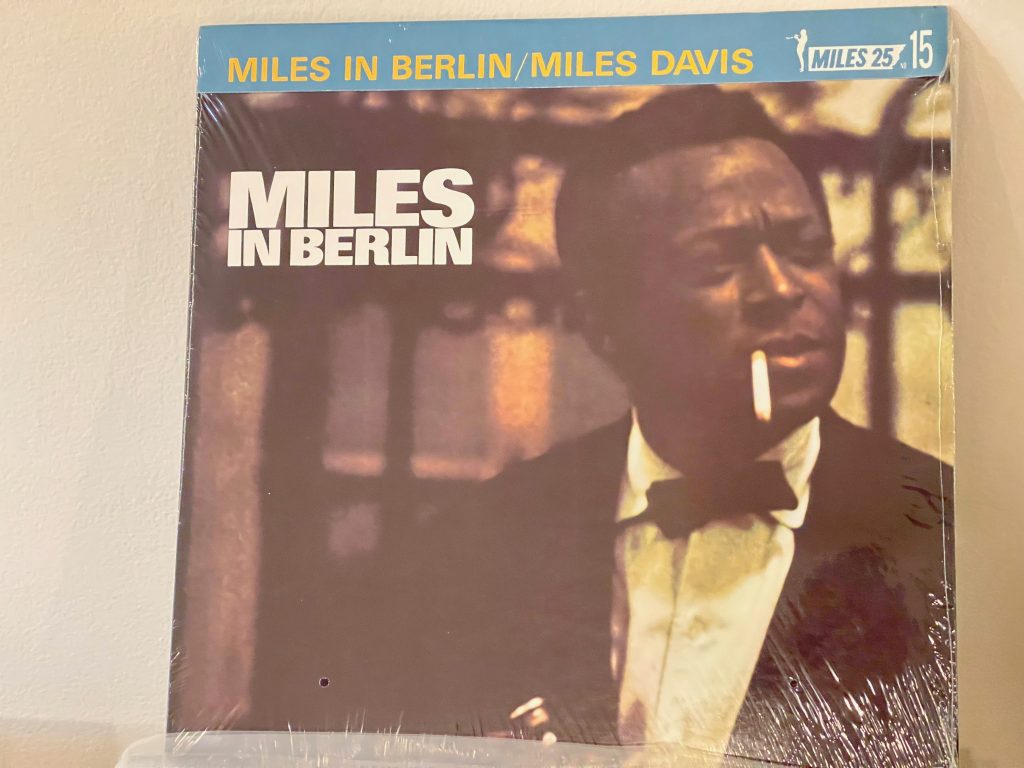
Album of the Week, May 28, 2022
Jumping forward a year from last week’s Herbie Hancock album, we find another Miles Davis quintet on tour in Berlin. Much is the same as when we last saw Miles with a small group: the format is the same, much of the repertoire is the same. But the players are completely different, and that puts this date on a different planet.
After recording Someday My Prince Will Come and the two live albums that followed, Miles’ rhythm section had split to form a piano trio. Miles spent much of 1962 trying to make an album with Gil Evans and his orchestra, but the result (Quiet Nights) was enough of a disappointment artistically and commercially that it put an end to that long collaborative string between the two men. Miles formed another quintet, this time with George Coleman on tenor, Victor Feldman on piano, Frank Butler on drums, and a young bassist named Ron Carter, who had debuted a year previously in a trio with the avant-garde Eric Dolphin and Mal Waldron. They recorded the album Seven Steps to Heaven, which stands out in Miles’ early 1960s output as a cohesive, well played recording with strong tunes (mostly written by Feldman). But Feldman and Butler didn’t want to move to the East Coast, and by May of 1963, Miles had recruited the young Tony Williams, then Herbie Hancock, to join the trio.
The new quintet played at Philharmonic Hall (recording the live albums My Funny Valentine and Four and More), and toured widely through the end of 1963 and most of 1964, but Coleman wasn’t clicking. Miles had played in mid-1963 with another tenor player, Wayne Shorter, who had been the chief composer in a well-regarded run with Art Blakey’s Jazz Messengers. Miles finally convinced Shorter to join his group in the summer of 1964, and on September 25 they played a concert at the Berlin Philharmonic. It would be the first recording released of the new quintet.
The repertoire may have been familiar but the performances weren’t. From the opening of “Milestones,” Tony Williams signals that something is different, playing a polyrhythm under the opening cymbal ride and dropping bombs at unpredictable points under Miles’ solo. The challenge invigorates Miles, who briskly runs through modal scales until he finds a countermelody, all the while playing with bebop velocity. He finishes the solo, then hands off to Wayne Shorter, who similarly embraces Coltrane-like runs, then drops into a swinging turn for a moment only to return to the trapeze. Over Hancock’s block chords, he embraces another run, then drops back into a swinging pattern, then imitates the block chords in the piano, playing in triplet groups, breaking down the melody into bursts of sound, Williams and Carter imitating him along the way. It’s a remarkable opening, and completely transforms the standard. This would be the rule for the night.
“Autumn Leaves” is opened with an atmospheric solo by Miles, with the barest sketch of chords in the piano underneath, until he suddenly locks into a swinging groove. Williams follows the groove, keeping the beat with the brushes but introducing patterns which Miles reflects in the trumpet, then Herbie picks up in the piano. It’s simultaneously the most traditional and the most free performance on the record.
“So What” opens with Carter and Hancock trading off over another Williams polyrhythmic accompaniment in the cymbals. (Much of Tony Williams’ playing on this record makes me long for a meeting between him and Stewart Copeland.) Here Herbie’s chords take the changes into unfamiliar territory around the outside fringes of the mode. Shorter bends the melody and chords further as Herbie gives him more and more space to open things up, then comes back in with clusters of sound. Shorter’s performance here underscores one of the chief differences between him and Coltrane at this stage: both embrace a reaching style that uses runs of notes as a building block, but Shorter finds patterns of silence in the middle of his performance, as well as rhythmic patterns that form countermelodies. Throughout the rhythm section plays almost telepathically with the soloists.
“Walkin’” returns as a theme and becomes another brisk workout for the soloists. Here Miles picks up on Shorter’s trick from “So What,” varying the runs with alternating rhythmic patterns before yielding to Tony Williams for a drum solo. Throughout Shorter’s solo he and Hancock trade ideas, discovering a new melody and actually falling into the tag of the melody from “Milestones” before handing off to the rhythm section. In later years, Miles and his band would play long uninterrupted sets where the tunes would telepathically flow into each other, and this moment feels like a forerunner of that. Hancock takes a breath in his solo, decelerating with Williams into something like a blues by way of Debussy before accelerating back to the breakneck tempo of the opening over 32 bars. Finally, “The Theme” provides Carter with a brief spotlight followed by the emergence of yet another new melody courtesy of Herbie Hancock.
With this quintet, Miles had found musicians who challenged him and pushed him further to innovate, even as together they found something like a group mind. And this recording was just the very beginning. Soon Shorter would bring his compositional voice to the party, lifting the band to the next level. We will hear that voice in one of his early masterpieces next time.
(Note: This review is written based on the LP version of this live recording—in this case, a 1981 reissue of the original 1967 release. The full concert, which is available on CD and in streaming and downloadable version, also included a performance of “Stella by Starlight.”)
You can hear Miles in Berlin here.

2 thoughts on “Miles Davis, Miles in Berlin”